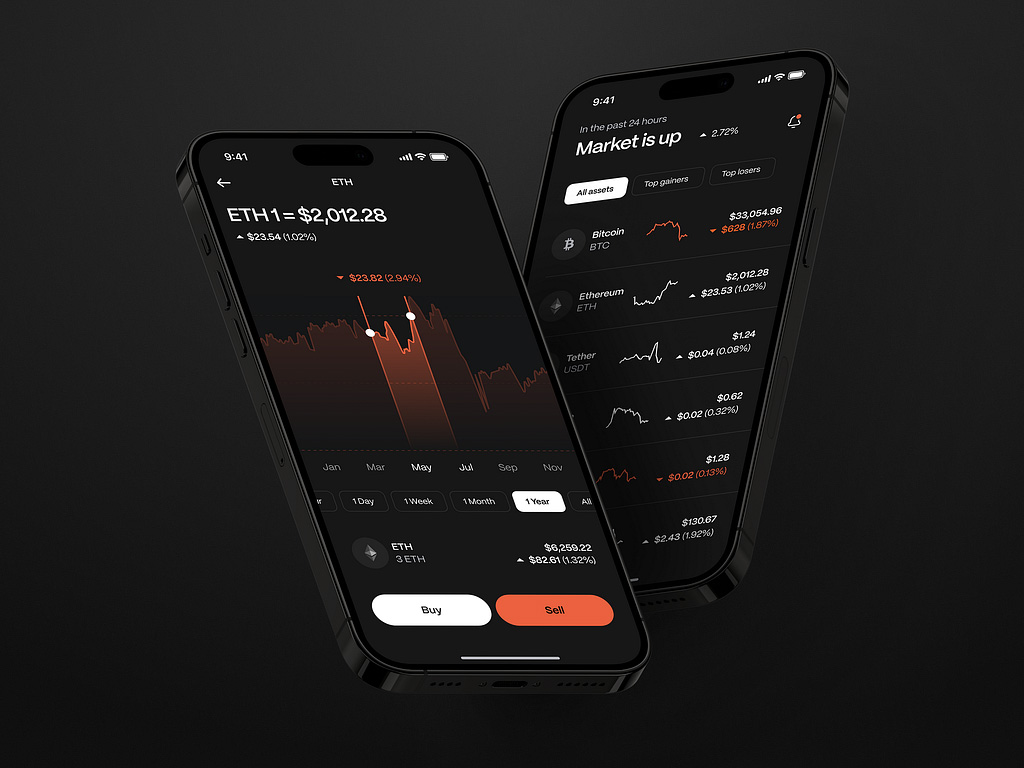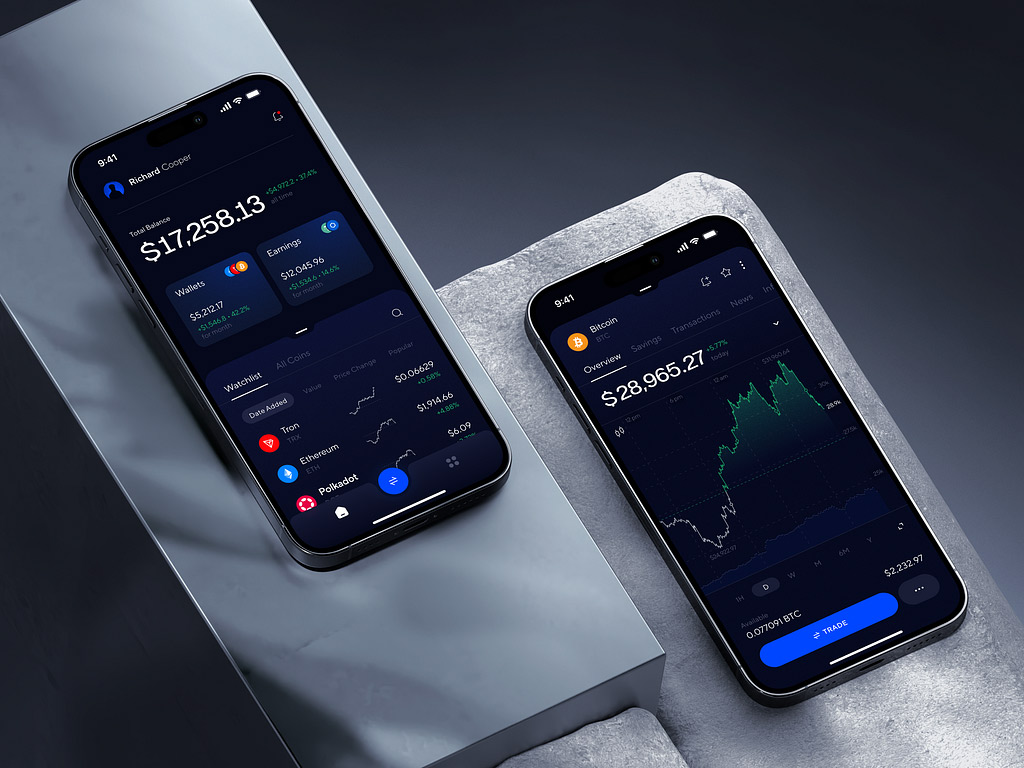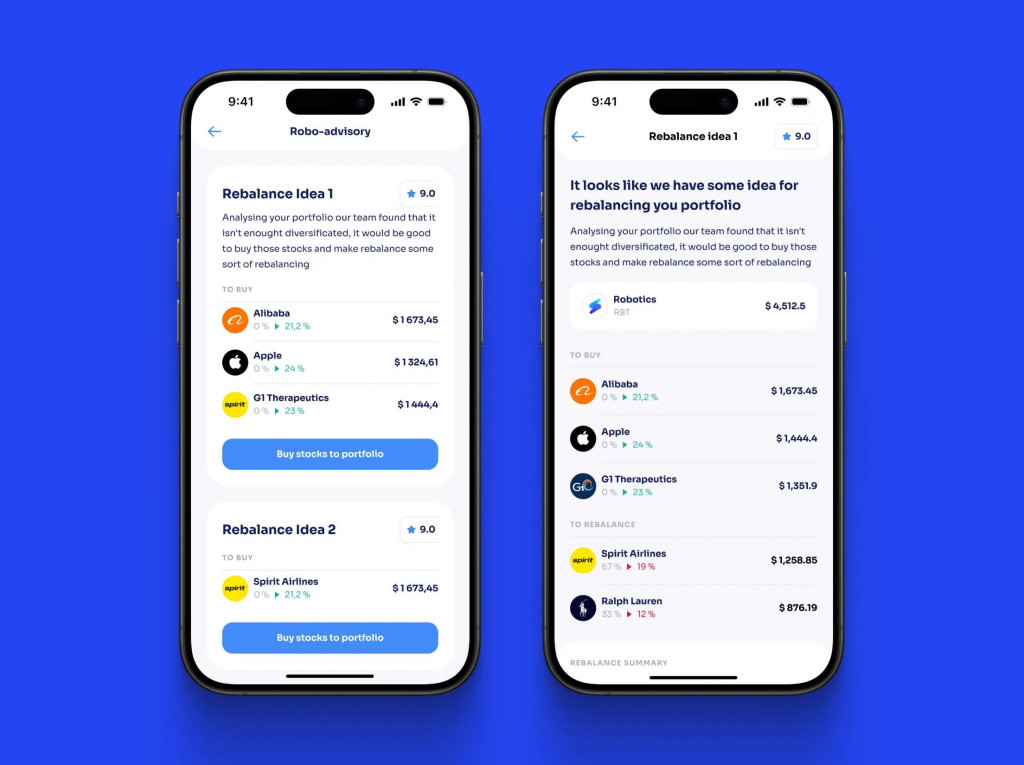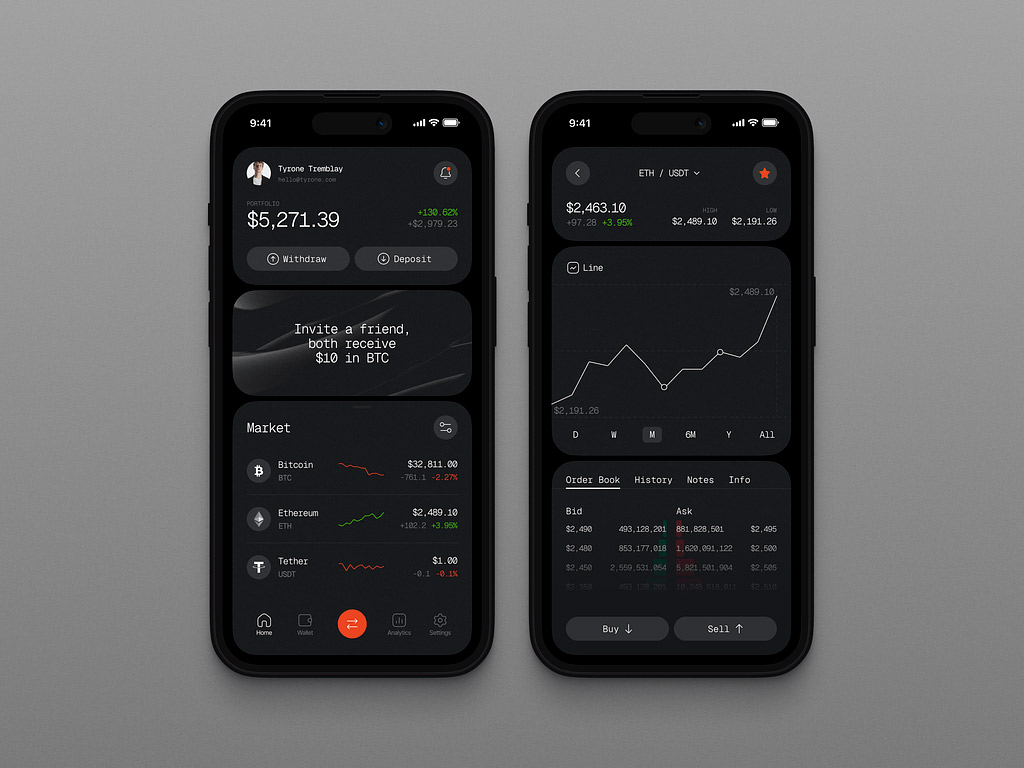The stock trading app market offers lots of opportunities for startups and rising businesses if you can take advantage of the latest trends and demands. To become a key player, you need to launch a competitive product that will catch the target audience’s attention from the start. Here you might be wrestling with questions like, “How do I create a secure app that stands out?” or “What features are essential to attract and retain users?”
Contents:
We’ll break down the entire process of building stock trading apps, from understanding the market landscape to essential features, tech stacks, and effective design strategies. By the end, you’ll have the insights and tools to navigate this complex journey confidently.
Stock Trading App Market
The market has experienced significant growth in recent years, fueled by the increasing adoption of mobile technology and the rise of retail trading. The global stock trading app market was valued at approximately $11 billion in 2022 and is projected to reach $30 billion by 2030, growing at a CAGR of around 15%.
Over 80 million retail investors in the United States alone use stock trading apps, with a significant rise in interest from Millennials and Gen Z.
Key Trends in Trading App Development
There are several tendencies you should consider when working on a stock trading app.
The rise of social trading, where users can follow and replicate successful investors’ trades, is changing the dynamics of the apps. Beginners can gain insights from a diverse trading group and improve market comprehension.
At the same time, many products are beginning to offer cryptocurrencies, catering to the growing interest in digital assets alongside traditional stocks. This way, they expand their target audience and offer more useful features.
Since more and more people learn about trading, there is a growing emphasis on providing educational content within apps to empower users to make well-informed trading decisions.
The integration of AI and machine learning has revolutionized trading strategies and user experiences, with apps now providing personalized suggestions and robo-advisors.
A growing number of retail investors are entering the market, favoring mobile platforms for trading, which has propelled the demand for stock trading apps.
Creating an online stock trading application can be a lucrative venture, given the ongoing demand and user interest in mobile trading solutions. However, competition is fierce, and success hinges on unique features and solid engagement.
Popular Stock Trading Apps
Leading products include Robinhood, E TRADE, TD Ameritrade, and others, each offering unique features to attract different segments of users. You can research their pros and cons to take advantage of them later during development.
Robinhood is known for popularizing commission-free trading in the U.S., catering primarily to younger, novice investors. It offers commission-free trading for stocks, options, ETFs, and cryptocurrencies. The app also allows users to earn interest on uninvested cash and provides a debit card. Or they can buy a fraction of a share, making it easier to invest in high-priced stocks.
E*TRADE is a reputable online brokerage with a more comprehensive platform aimed at both novice and experienced traders. It provides a wide range of investment options: stocks, options, ETFs, mutual funds, and bonds. Still, the app also has cool features for serious traders, like extensive market research, analysis tools, and educational resources.
TD Ameritrade is a well-established brokerage known for its comprehensive trading platform and extensive resources for investors. There are advanced trading tools and features for active traders and options trading. Also, it offers commission-free online trading for stocks and ETFs.
Now that you have a general market understanding, let’s see how to build a stock trading app.

Crypto Trading Mobile App by Conceptzilla
Key Features of an Online Stock Trading Application
Before deciding on essential and non-essential functionalities, you need to take time to research. Ask yourself a few questions. For example, what’s your target audience? What user’s problems will your app solve? What options are represented poorly among competitors?
Once you have that information, you can start packing the toolkit and focus on building a scaled-down version of your app with only the essential features to test the market. Use the MVP to gather user feedback and iterate on the design before scaling up. This way, you avoid wasting resources and save precious time.
Essential Functionalities
Here’s a list of must-have features in order to make the stock app competitive:
- User-friendly interface: Fintech apps are often data-heavy, so the interface should be easy to navigate, allowing users to find options easily.
- Real-time market data: Traders need access to live stock quotes and market news to make informed decisions.
- Research tools: Features that provide analysis, charts, and market insights are critical.
- Various tradable assets: The app should support different asset classes, including stocks, ETFs, and more.
- Security features: Robust security protocols to protect user data and transactions are essential.
- Push notifications and alerts: Traders benefit from timely alerts for price changes and market news.
- Low brokerage fees: Competitive pricing is crucial for attracting potential users.
Advanced Functionalities
If your target audience consists of pro-level traders, then you can integrate advanced functionalities. They enable professionals to refine their strategies and enhance their trading performance. However, keep in mind, that they take more time during stock trading software development.
Here are some examples:
- Advanced charting tools: Allow for detailed technical analysis, including multiple indicators and customizable chart settings.
- Diverse asset access: Provide access to a wider range of assets, including over 900 trading options with pro accounts, enhancing portfolio diversification.
- In-depth market analysis: Comprehensive market reports and analysis help professionals make informed decisions.
- Strategic position sizing: Advanced strategies for managing trade sizes and risk are crucial for maximizing profits and minimizing losses.
- Professional trading tools: Features like order types, margin management, and real-time analytics are essential for executing trades efficiently.
Tech Stack for Stock Trading Apps
Building a fintech app requires a well-thought-out technology stack. It greatly depends on the features, their complexity, and your team skills. Here are some technologies you can leverage in trading app development:
Frontend Technologies:
- Frameworks: Use React or Angular for a dynamic and responsive user interface.
- Languages: HTML, CSS, and JavaScript are essential for web development.
Backend Technologies:
- Languages: Node.js, Python, or Java can be effective for server-side logic.
- Frameworks: Express.js (for Node.js) or Django (for Python) are suitable choices.
Database:
- SQL Databases: PostgreSQL or MySQL for structured data storage.
- NoSQL Databases: MongoDB can be used for flexibility in data modeling.
APIs:
Integrate with third-party APIs for real-time market data and trading functionalities.
Security:
Implement OAuth for user authentication and SSL for secure data transmission.
Cloud Services:
Use platforms like AWS or Azure for hosting, storage, and scalability options.
DevOps Tools:
Tools like Docker for containerization and Kubernetes for orchestration can streamline deployment and scalability.
This combination provides a robust foundation for stock trading software development.

Abyss app by Conceptzilla
Stock Trading App Costs
The approximate cost of developing a stock trading app can range from $50,000 to $300,000 or more, depending on various factors. Let’s break down the cost components and influencing factors.
Team Composition
The team’s experience and expertise have a great influence on your expenses. Senior specialists in finance-related applications typically demand higher rates. If you hire full-stack developers, it might be cheaper. Also, the costs depend on the team type: outsourcing or in-house. The first one will typically offer lower prices. In this case, the average hourly price is $40-45 for development and $70-80 for design.
However, apart from the developers, you also need:
- UI/UX Designers: To create user-friendly interfaces.
- Quality Assurance (QA): To test and ensure the app’s reliability.
- Project Manager: To oversee the project and ensure timely delivery.
- Financial and security consultant: To deal with legal requirements that vary from country to country.
Development Time
In the fast-paced world of trading app development, time is a critical factor that can significantly impact the success of your project. Longer development times often lead to increased costs. More complex features (e.g., real-time trading, advanced analytics) will extend development time, increasing the expenses. Streamlining your process to achieve a quicker launch can help manage budgets more effectively, allowing for resource reallocation to marketing or future updates.
Technology Stack
The choice of technologies can influence costs in several ways.
- Firstly, more robust and secure technologies incur higher expenses. At the same time, a tech stack may appear cost-effective initially but may lead to higher maintenance costs later. Balancing upfront expenses with long-term sustainability is crucial for a successful project.
- Different tech stacks have varying levels of complexity. A simpler stack can reduce development time, while a more complex one may require more resources, resulting in higher costs. So if you are already running out of time, there is no need to pick skill-demanding tools.
- The availability of skilled trading platform developers for a specific technology can impact costs. You might find affordable talent if your chosen stack is popular and widely used. Conversely, niche technologies require hiring expensive specialists, increasing overall expenses and time to find that talent.
- Some technologies are easier to maintain than others. Choosing a stack that requires less ongoing effort can save costs in the long run, as regular updates and bug fixes can be time-consuming and expensive.
- When developing cross-platform applications, some toolkits offer better support for multiple platforms, which can reduce the need for separate codebases. This can significantly lower development and maintenance costs.
Compliance and Security
Ensuring regulatory compliance and implementing robust security measures are a must-have trading app development but can significantly increase development costs.
As we said before, different industries and regions have specific regulations (e.g., GDPR, HIPAA). Complying with these laws may require additional features, legal consultations, or audits, all of which raise development costs.
Incorporating robust security measures—such as encryption, secure user authentication, and data protection—adds to initial development expenses. However, these features are essential to protect user data and comply with regulations, thus preventing potential legal issues.
Depending on the nature of your stock trading app, you may want to consider obtaining liability insurance to cover incidents related to legal compliance and security breaches. This can be an additional line item in your budget.
How to Build a Stock Trading App
Planning and researching
Research doesn’t end with discovering the target audience or competitors. You have to figure out many things and shape them into a detailed business plan.
Create a budget that includes development, marketing, maintenance, and compliance costs. Explore options for financing your project, such as angel investors, venture capital, or crowdfunding.
Develop a brand identity and marketing strategy to attract users. Social media, content marketing, and partnerships with financial influencers are easy ways to gain attention from the target audience. To keep the traction going, plan for user retention strategies, such as loyalty programs and educational content.
Since you will work with sensitive financial information, you need to research the legal requirements for stock trading apps in your target markets, such as licensing, KYC (Know Your Customer), and AML (Anti-Money Laundering) policies. What’s more, regulations like GDPR or CCPA will also affect how you handle user data. Adhering to these requirements may look troublesome, but you’ll be better equipped to create a successful product that meets the needs of your target audience.
During our collaboration with Solio, we conducted thorough research on the Korean stock market. We studied top stock trading apps in Korea, broke down their UX, and deconstructed features to find dependencies.

Solio app by Shakuro
Creating UI/UX Design
Once you have a detailed plan at hand, you can start bringing it to life step by step. The first one is to turn words into interface lines.
A UI/UX design for a stock trading app should be functional, engaging, and tailored to the needs of your target audience, ultimately leading to a positive user experience. Since timing is crucial in the financial sphere, and people don’t want to fight with navigation, the layout should be glanceable. Simplified designs improve decision-making and appeal to beginner traders.
Information Architecture
- Define structure: Organize information logically. Plan how users will navigate through various features such as account management, market data, and trading functionalities.
- Wireframing: Create low-fidelity wireframes to map out the layout and flow of the app, focusing on key elements like navigation bars and trading interfaces.
- Visual design: Build high-fidelity wireframes for user testing. They should reflect your brand identity while ensuring readability and accessibility. Utilize size, color contrast, and whitespace to prioritize key information, making it easy for users to focus on what matters.
- Graphs and charts: Implement intuitive and interactive charts for stock prices, trends, and portfolio performance. Use visual elements that can display complex data.
User Testing
- Gather Feedback: Regularly conduct usability tests with real users to identify pain points and areas of improvement.
- Test Across Platforms: Conduct tests on different target platforms to ensure functionality and usability remain consistent regardless of the device used.
- Iterate Based on Feedback: Make adjustments to the design based on user feedback, continually refining the interface for better usability.
Trading App Development
App Architecture Design
- Choose Architecture Pattern: Select an architecture pattern (e.g., MVC, MVVM) to structure the app, making it scalable and maintainable.
- Data Security: Implement robust security measures to protect sensitive user data, ensuring encrypted communications and secure data storage.
Development Phase
- Frontend Development: Implement the user interface, interactive elements, and animations, ensuring responsiveness across different devices.
- Backend Development: Develop the server-side logic, database schema, and API endpoints necessary for handling user requests and trading operations.
- Real-Time Data Handling: Use WebSocket or similar technologies to provide real-time updates on market data, trades, and alerts to users.
Testing and Quality Assurance
- Functional Testing: Thoroughly test all features of the stock trading app to ensure they work as intended, including trading functionalities and user authentication.
- Security Testing: Conduct penetration testing and vulnerability assessments to identify and resolve security issues.
- User Acceptance Testing (UAT): Gather feedback from beta users to finalize any changes before the full launch.
Deployment
- Choose Hosting Provider: Select an appropriate cloud solutions provider (AWS, Google Cloud, etc.) for deploying your backend services.
- App Store Submission: Package the mobile app and submit it to the appropriate app stores (Apple App Store, Google Play Store) following their guidelines.

Crypto App Design Concept by Conceptzilla
Post-Launch Considerations
The release is just the beginning. Now you need to maintain and scale the app to grow your business. Here are a few strategies you can leverage:
- Monitoring and Analytics: During trading app development, implement real-time monitoring tools to track app performance after release. You can use analytics to understand user engagement, behavior, and usage patterns.
- Bug Fixes and Updates: Establish a system for users to report bugs and issues. Regularly release updates to fix bugs and enhance features based on the feedback.
- Security Enhancements: Frequently update encryption protocols and security measures to protect user data. Conduct penetration testing and vulnerability assessments to identify potential weaknesses.
- Compliance and Regulations: Stay in the flow with financial regulations and ensure your stock trading app complies with legal requirements. Prepare for potential audits by maintaining thorough documentation.
- Performance Optimization: Analyze performance metrics and optimize the app for speed and efficiency. Regularly review server capacity and scalability, especially during peak trading times.
- Feature Iteration and Roadmap Planning: Develop a clear product roadmap based on user needs and market trends. Continuously iterate on features, adding new ones that enhance the experience.
- Data Integrity and Backup: Implement regular data backups to prevent data loss. Ensure data integrity with regular audits and checks on your databases.
Conclusion
Now you know how to create a trading platform. It is an ambitious yet rewarding endeavor that requires careful planning and execution. Understanding the competitive landscape and regulatory requirements is crucial, as it helps in tailoring your app to meet user needs while adhering to legal standards.
As you lay the groundwork, embracing current trends such as AI integration for personalized trading insights, mobile-first approaches for accessibility, and advanced security measures to protect user data will set your application apart in a crowded market.
By following these steps and staying attuned to industry trends, you can successfully develop a product that meets market demands and fosters user trust and engagement.
To create a stock trading app, you need an experienced team. Contact us and let’s work together on your future projects.

